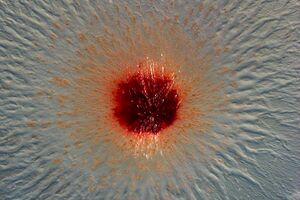Pendulispora rubella: Difference between revisions
| Line 41: | Line 41: | ||
==Cell Structure, Metabolism and Life Cycle== | ==Cell Structure, Metabolism and Life Cycle== | ||
"Pendulus" meaning 'hanging so as to swing freely or hanging downward' [2] is the prefix for Pendulispora. This is to illustrate the way that <i>P. rubella</i> bears its spores. | "Pendulus" meaning 'hanging so as to swing freely or hanging downward' [2] is the prefix for Pendulispora. This is to illustrate the way that <i>P. rubella</i> bears its spores. An advancing swarm colony pattern with flare-like edges, slender rod-shaped vegetative cells, and dormant spores can characterize its growth. <i>P. rubella</i> MSr11367T produces a family of N-terminally acetylated and C-terminally reduced tetrapeptides with an all L-configured amino acid sequence. <i>P. rubella</i> has a unique set of cellular machinery contributing to its metabolism and function. The genes that encode their synthesis mechanics display unparalleled enzymatics. The first ever discovered non-ribosomal peptide synthetase acetylation domain was found within their genome [2]. <i>P. rubella</i> releases rounded spores during spore dispersal that appear powdery. | ||
An advancing swarm colony pattern with flare-like edges, slender rod-shaped vegetative cells, and dormant spores can characterize its growth. | |||
<i>P. rubella</i> MSr11367T produces a family of N-terminally acetylated and C-terminally reduced tetrapeptides with an all | |||
<i>P. rubella</i> has a unique set of cellular machinery contributing to its metabolism and function. The genes that encode their synthesis mechanics display unparalleled enzymatics. The first ever discovered non-ribosomal peptide synthetase acetylation domain was found within their genome [2]. | |||
<i>P. rubella</i> releases rounded spores during spore dispersal that appear powdery. | |||
==Ecology and Pathogenesis== | ==Ecology and Pathogenesis== | ||
Revision as of 16:59, 19 November 2024
Classification
Bacteria; Myxococcota; Myxococcia; Myxococcales; Sorangiineae; Pendulisporaceae
Species
|
NCBI: [1] |
Pendiluspora rubella (MSr11367)
Description and Significance
Describe the appearance, habitat, etc. of the organism, and why you think it is important.
P. rubella has a wide range of acid tolerance as it can grow in a pH range of 4-12. This mesophilic organism can thrive in conditions where the temperature range is 18°C-37°C. Unlike other myxobacteria, P. rubella forms a unicellular fruiting body producing powdery round spores and does not form a sporangial coat nor a slime envelope around the spores.
Genome Structure
Describe the size and content of the genome. How many chromosomes? Circular or linear? Other interesting features? What is known about its sequence?
Pendulispora rubella (MSr11367) has a circular genome with 10,733 total genes. Named GCF_037157805.1-RS_2024_10_26 and fully mapped on 10/26/2024 12:40:18.
Cell Structure, Metabolism and Life Cycle
"Pendulus" meaning 'hanging so as to swing freely or hanging downward' [2] is the prefix for Pendulispora. This is to illustrate the way that P. rubella bears its spores. An advancing swarm colony pattern with flare-like edges, slender rod-shaped vegetative cells, and dormant spores can characterize its growth. P. rubella MSr11367T produces a family of N-terminally acetylated and C-terminally reduced tetrapeptides with an all L-configured amino acid sequence. P. rubella has a unique set of cellular machinery contributing to its metabolism and function. The genes that encode their synthesis mechanics display unparalleled enzymatics. The first ever discovered non-ribosomal peptide synthetase acetylation domain was found within their genome [2]. P. rubella releases rounded spores during spore dispersal that appear powdery.
Ecology and Pathogenesis
Habitat; symbiosis; biogeochemical significance; contributions to environment.
If relevant, how does this organism cause disease? Human, animal, plant hosts? Virulence factors, as well as patient symptoms.
Pendulispora rubella is a soil-living organism
References
Author
Page authored by Colleen Bolmanski, Dakota Lowery, & Beckham LaBarbera, students of Prof. Bradley Tolar at UNC Wilmington.

